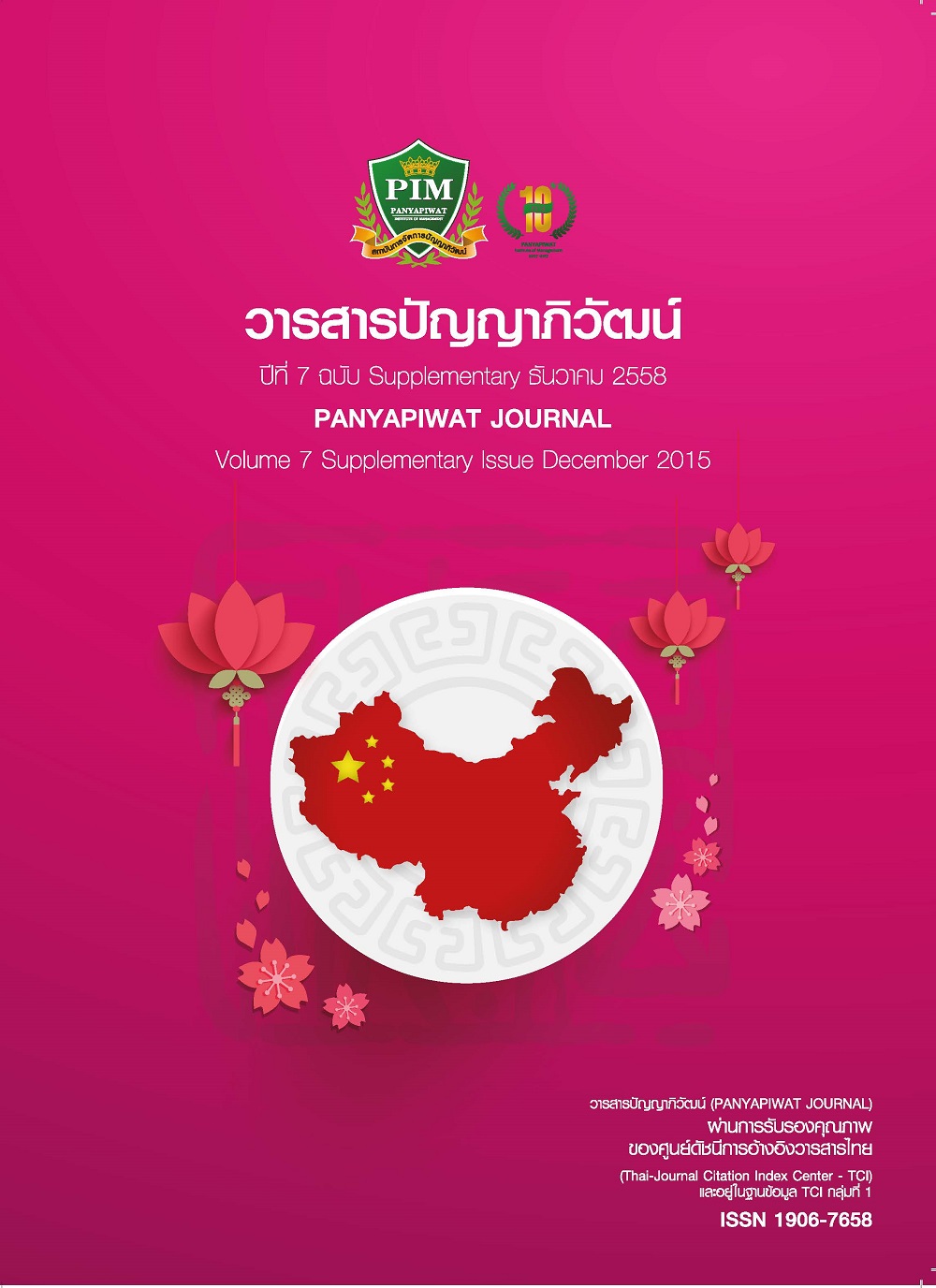MESSAGE STRATEGIES AND YOUTH’S INTERPRETATION ON TELEVISED ANTI-SMOKING ADVERTISING CAMPAIGNS
Main Article Content
บทคัดย่อ
The study targeted to studying an agreement between message strategies used- advertising appeals and advertising execution in televised anti-smoking advertising campaigns, both in general and participatory types and tailored between 2011 and 2013 and youth’s interpretation on such smoking cessation campaigns launched on television stations. The mix methods of content analysis, documentary research, in-depth interviews, and focus groups were, therefore, employed. The findings revealed that there was a shared agreement between what the Thai Health Promotion Foundation per se intended to convey and that what the youths interpreted. This just happened with the general televised anti-smoking advertisements, not with being exposed to the ones created by the youths. It was specifically apparent that emotional appeals and information/rational appeals were delivered in both types of advertisements. Although reminder advertising was disseminated in the general types, it was not seen in their counterparts. However, teaser advertising was highlighted in participatory advertisements, but not for reminder advertising.
The youths shared their perspectives that more odds of perceived awareness, feelings, and acceptance were generated when smokers and nonsmokers were being exposed to the advertisements initiated by the Thai Health Promotion Foundation than the ones produced by the youths. Failures in the participatory advertising were because of their specific target audiences, no impacts of changing smoking behaviour, and perceived negative image and thoughts on those who smoked. This research contributed to the further development of an advertisement and campaign focusing on a particular target group including secondhand smokers, male smokers, and female smokers.
งานวิจัยชิ้นนี้มีวัตถุประสงค์เพื่อศึกษากลยุทธ์ กรณีนี้มุ่งศึกษาแรงจูงใจและการดำเนินการในโฆษณา ในภาพยนตร์โฆษณารณรงค์เลิกสูบบุหรี่ทางโทรทัศน์ ทั้งที่ผลิตโดย สสส. และเยาวชนที่เข้ามามีส่วนร่วม ในปี พ.ศ. 2554-2556 และการตีความของเยาวชนผู้รับสารต่อภาพยนตร์โฆษณารณรงค์ดังกล่าว งานวิจัยชิ้นนี้เป็นงานวิจัยเชิงผสมผสาน โดยประกอบด้วยการวิเคราะห์เนื้อหา (Content Analysis) การวิจัยเอกสาร (Documentary research) การสัมภาษณ์ (In-depth interviews) และการสัมภาษณ์กลุ่ม (Focus groups) ผลการวิจัยพบว่า มีความสอดคล้องกันระหว่าง ความตั้งใจของผู้ส่งสารที่จะส่งสารออกไปและการตีความของเยาวชน ซึ่งกรณีนี้จะเกิดขึ้นแต่เฉพาะโฆษณารณรงค์เลิกสูบบุหรี่ของ สสส. เท่านั้น ผลการวิจัยชี้ให้เห็นอย่างชัดเจนว่า โฆษณาทั้ง 2 แบบ ใช้กลยุทธ์ด้านอารมณ์ความรู้สึกและกลยุทธ์ด้านข้อมูลเหตุผล แม้ว่าการใช้กลยุทธ์ด้านการย้ำเตือนจะถูกใช้ในโฆษณารณรงค์เลิกสูบบุหรี่ของ สสส. แต่ไม่เกิดขึ้นในโฆษณารณรงค์แบบมีส่วนร่วมของเยาวชน แต่การใช้กลยุทธ์ด้านการยั่วเย้าจะพบได้ในภาพยนตร์โฆษณารณรงค์แบบมีส่วนร่วมของเยาวชน แต่ไม่พบในโฆษณารณณงค์เลิกสูบบุหรี่ของ สสส.
ขณะที่เยาวชนสูบบุหรี่และไม่สูบบุหรี่ เมื่อดูโฆษณาของ สสส. จะมีความตระหนัก มีความรู้สึกร่วมและการยอมรับมากกว่าโฆษณารณรงค์เลิกสูบบุหรี่แบบมีส่วนร่วมของเยาวชน ความล้มเหลวของโฆษณาที่เยาวชนผลิตเกิดขึ้นจากการมีกลุ่มเป้าหมายเฉพาะเจาะจงมากเกินไป ไม่มีผลกระทบต่อการเปลี่ยนแปลงพฤติกรรมการสูบบุหรี่และเกิดภาพลักษณ์ เกิดความคิดในเชิงลบต่อคนที่สูบบุหรี่ งานวิจัยชิ้นนี้ก่อให้เกิดประโยชน์ในด้านการพัฒนาภาพยนตร์โฆษณารณรงค์เลิกสูบบุหรี่ และโครงการรณรงค์ที่เป็นเฉพาะกลุ่มเป้าหมายใดเป้าหมายหนึ่ง เช่น กลุ่มผู้สูบบุหรี่มือสอง กลุ่มผู้สูบบุหรี่ชายและหญิง
Article Details
“ข้าพเจ้าและผู้เขียนร่วม (ถ้ามี) ขอรับรองว่า บทความที่เสนอมานี้ยังไม่เคยได้รับการตีพิมพ์และไม่ได้อยู่ระหว่างกระบวนการพิจารณาลงตีพิมพ์ในวารสารหรือแหล่งเผยแพร่อื่นใด ข้าพเจ้าและผู้เขียนร่วมยอมรับหลักเกณฑ์การพิจารณาต้นฉบับ ทั้งยินยอมให้กองบรรณาธิการมีสิทธิ์พิจารณาและตรวจแก้ต้นฉบับได้ตามที่เห็นสมควร พร้อมนี้ขอมอบลิขสิทธิ์บทความที่ได้รับการตีพิมพ์ให้แก่สถาบันการจัดการปัญญาภิวัฒน์หากมีการฟ้องร้องเรื่องการละเมิดลิขสิทธิ์เกี่ยวกับภาพ กราฟ ข้อความส่วนใดส่วนหนึ่งและ/หรือข้อคิดเห็นที่ปรากฏในบทความข้าพเจ้าและผู้เขียนร่วมยินยอมรับผิดชอบแต่เพียงฝ่ายเดียว”
References
Advertising Association of Thailand. (2015). Ad Expenditure. Retrieved October 30, 2015, from
Akkaworakit, N. (2008). Advertising creative strategy. Bangkok University.
Belch, G. E. & Belch, M. A. (2001). Advertising and promotion: An integrated marketing communications perspective. (5th ed.). New York: McGraw-Hill.
Chusin, P. (1998). Teaching about the Nature of Science in British National. Master thesis,
Pibulsongkram Rajabhat University. Foundation/American Cancer Society. (n.d.). The tobacco atlas. Retrieved May 3, 2015, from http://www.tobaccoatlas.org/topic/smoking s-death-toll/
Hawkins, D. L., Best, R. J. & Coney, K. A. (1995). Consumer behavior: Implication for marketing
strategy. (6th ed.). Chicago: Irwin.
Health Literacy Special Collection. (n.d.). From the first to the last ash: The history, economics &hazards of tobacco. Retrieved May 3, 2015, from http://healthliteracy.worlded.org/docs/tobacco/Unit3/1why people smoke.html
Jitaram, P. (2010). Research synthesis for smoking. Institute of Physical Education Suphanburi.
Julapongsathorn, M. (2001). Creative strategies and information content in Thai magzine advertising. Master thesis, Chulalongkorn University.
Keelapang, V. (2011). The effectiveness of the media campaign for Thai Health Promotion
Foundation In the youth aged between 15-24 years. Master thesis, Chulalongkorn University.
Klangrahad, C., Bhoon-Nak C. & Ruengvilaivate, L. (2006). Smoking behavior of female students.
Master thesis, Kasetsart University.
Mental Health Association Under the Royal Patronag. (2008). Teenagers and friends. Retrieved
March 31, 2015, from http://www.jitjai.com/2008/10/blog-post 7770.html
National Statistics Office. (n.d.). Statistics on viewing advertising through the media on a daily basis. Retrieved December 17, 2013, from http://www.nso.go.th/
National Statistics Office. (2012). The smoking and drinking behaviour survey 2011. Retrieved May
, 2015, from http://service.nso.go.th/nso/nsopublish/themes/files/smokeRep54.pdf
Paosawatyanyong, B. (2003). Lifestyle patterns and exposure to advertising campaigns, films with the decision to buy materials and audio recording of movies. The population of Bangkok.Thammasat University: Bangkok.
Poorat, T. (2005). Approach of advertising: strategies and processes. Thammasat University:
Bangkok.
Phanucharas, D. & Chalongsuk, R. (2009). Smoking behavior and smoking-related knowledge of students at Silpakorn University, Thailand. Silpakorn U Science & Tech J, 3(1), 34-43.
Rook, D. W. (1985). The ritual dimension of consumer behavior. Journal of Consumer Research.12(4): 251-264.
Sampattavanich, S. (2003). Motivation and Advertising. Thammasat University: Bangkok.
Samroeng, S. (2002). Message strategy and consumers' responses toward public service advertising
in television. Master thesis, Chulalongkorn University.
Sangloung, K. (n.d.). Advertising Creative Strategy. Retrieved February 18, 2558, from http://
kwuancheewa.exteen.com/page/16
Sareerat, S. (1994). Advertising and promotion management. Bangkok: P. S. Pattana.
Sirirassamee, T., Sirirassamee, B., Borland, R., Fong, G. T. & Hammond, D. (2012). Adolescents'perceptions of the new anti-smoking advertisement. Findings from the ICT Thailand Survey. Poster, presented at the WCTOH in Singapore.
Sperber, D. & Wilson, D. (1986). Relevance: Communication and Cognition. Oxford: Blackwell.
Sriwisai, V. (2008). Strategies to create advertising messages in the media and interpretation of consumers. School of Educational Studies. Master thesis, Sukhothai Thammathirat Open University.
Thai Health Promotion Foundation. (n.d.). About us. Retrieved May 3, 2015, from http://www.thaihealth.or.th/Aboutus.html
Thai Health Promotion Foundation. (2007). Female students' smoking. Retrieved October 30, 2015,
from http://www.thaihealth.or.th/Content/20073
Thongmeearkom, P. (1988). The effects of spacing and repetition of identical and varied versions
of TVCS on advertising recall and recognition. Master thesis, Chulalongkorn University.
Tufte, T. & Mefalopulos, P. (2009). Participatory Communication: A practical guide. Washington, D.C.: The International Bank for Reconstruction and Development/The World Bank.
Utsahakit, C. (1989). The content analysis of public relations advertising commercials. Master thesis, Chulalongkorn University.
Vichit-Vadakan, N., Aekplakorn, W., Tanyanont, W. & Poomkachar, H. (2004). Prevalence of smoking and related factors in school students in Thailand. Retrieved May 3, 2015, from http://www.seatca.org/dmdocuments/41_prevalence_of_smoking_and_related_factors_in_school_students in thailand.pdf
Well, W., Burnett, J. & Moriarty, S. (1989). Advertising: principles & practice. (1th ed.). Upper Saddle River, NJ: Prentice-Hall.
William, W., Sandra, M., John, B. & May, L. (2007). Advertising-Principles and Effective IMC Practice.
Pearson Prentice Hall: Singapore.
World Health Organization Regional Office for South-East. (2008). Thai Health Promotion Foundation. Retrieved May 3, 2015, from https://apps.who.int/infobase/Mortality.aspx?l=&Group1=RBTCntyByRg&DDLCntyByRg=SEAR&DDLCntyName=1005&DDLYear=2004&TextBoximgName=go
Zawahir, S., Omar, M., Awang, R., Yong, H., Borland, R., Sirirassamee, B., Fong, G. T. & Hammond,D. (2013). Effective of antismoking media messages and education among adolescents in Malaysia and Thailand. Findings from the International Tobacco Control Southeas.

